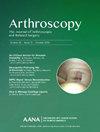Addition of Preoperative Ultrasound-Guided Suprascapular Nerve Block and Axillary Nerve Block to Parecoxib Is More Effective in Early Postoperative Pain Control After Arthroscopic Rotator Cuff Repair: A Prospective Randomized Controlled Study
IF 4.4
1区 医学
Q1 ORTHOPEDICS
Arthroscopy-The Journal of Arthroscopic and Related Surgery
Pub Date : 2024-10-01
DOI:10.1016/j.arthro.2024.02.031
引用次数: 0
Abstract
Purpose
To prospectively compare pain intensity and patient-reported outcomes (PROs) after arthroscopic rotator cuff repair (ARCR) between patients who received ultrasound-guided suprascapular nerve block (SSNB) and axillary nerve block (ANB) as well as preincisional parecoxib and patients who received preincisional parecoxib only.
Methods
Sixty-one patients receiving ARCR between March 2020 and March 2021 were prospectively enrolled. They were randomly assigned to the peripheral nerve block group (group N, n = 30) or control group (group C, n = 31). Two patients in group C were excluded because of miscommunication. All patients were administered 40 mg of parecoxib intravenously prior to induction of anesthesia. SSNB and ANB were performed after general anesthesia in group N, whereas no nerve block was performed in group C. Pain intensity was compared before surgery, as well as immediately, 24 hours, and 2 weeks after surgery. PROs, including the Oxford Shoulder Score, University of California–Los Angeles shoulder score, and Single Assessment Numeric Evaluation score, were compared before and 6 months after surgery.
Results
The numerical rating scale (NRS) score for resting pain was significantly lower in group N (4.9 ± 3.1 vs 7.6 ± 2.5, P < .001) immediately after surgery, but no difference was noted 24 hours after surgery. The resting pain NRS score 2 weeks after surgery was significantly lower in group N (1.4 ± 1.6 vs 2.7 ± 2.7, P = .03), but the scores for movement-evoked pain and night pain were similar. All PROs significantly improved 6 months after surgery in both groups, but there was no difference between the 2 groups.
Conclusions
The addition of preoperative ultrasound-guided SSNB and ANB to parecoxib offered better resting pain control immediately and 2 weeks after ARCR, but there was no benefit for PROs 6 months after surgery.
Level of Evidence
Level II, prospective randomized controlled trial.
一项前瞻性随机对照研究:在帕瑞昔布基础上加用术前超声引导的肩胛上神经阻滞和腋神经阻滞,对关节镜下肩袖修复术后早期疼痛控制更有效。
目的:该研究旨在前瞻性地比较接受超声引导下肩胛上神经阻滞(SSNB)和腋神经阻滞(ANB)以及手术前帕瑞昔布治疗的患者与仅接受手术前帕瑞昔布治疗的患者在关节镜下肩袖修复术(ARCR)后的疼痛强度和患者报告结果(PROs):在 2020 年 3 月至 2021 年 3 月期间接受 ARCR 的 61 名患者被纳入前瞻性研究。他们被随机分配到周围神经阻滞组(N 组,n=30)或对照组(C 组,n=31)。由于沟通不畅,C 组的两名患者被排除在外。所有患者在麻醉诱导前均静脉注射帕瑞昔布 40 毫克。N 组在全身麻醉后进行 SSNB/ANB,而 C 组未进行神经阻滞。术前、术中、术后 24 小时和 2 周的疼痛强度进行了比较。比较了手术前和手术后6个月的PROs,包括牛津肩关节评分、加州大学洛杉矶分校肩关节评分和单一评估数字评价评分:结果:N组患者的静息疼痛数字评定量表(NRS)明显降低(4.9 ± 3.1 vs. 7.6 ± 2.5,p):在帕瑞昔布的基础上加用术前超声引导的SSNB和ANB,可在ARCR术后即刻和2周内更好地控制静息痛,但术后6个月对PROs没有益处:2级前瞻性随机对照试验。
本文章由计算机程序翻译,如有差异,请以英文原文为准。
求助全文
约1分钟内获得全文
求助全文
来源期刊
CiteScore
9.30
自引率
17.00%
发文量
555
审稿时长
58 days
期刊介绍:
Nowhere is minimally invasive surgery explained better than in Arthroscopy, the leading peer-reviewed journal in the field. Every issue enables you to put into perspective the usefulness of the various emerging arthroscopic techniques. The advantages and disadvantages of these methods -- along with their applications in various situations -- are discussed in relation to their efficiency, efficacy and cost benefit. As a special incentive, paid subscribers also receive access to the journal expanded website.

 求助内容:
求助内容: 应助结果提醒方式:
应助结果提醒方式:


